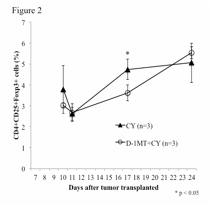Indoleamine 2,3-dioxygenase (IDO) catalyzes the rate-limiting step in the catabolism of tryptophan along the kynurenine pathway. In tumors, increased IDO activity inhibits T cell and natural killer cell proliferation and induces apoptosis. We have previously reported that IDO expression in lymphoma cells and serum concentration of kynurenine in diffuse large B-cell lymphoma are useful prognostic factors. Preclinical studies in rodents have demonstrated that IDO inhibitors, such as 1-methyl-D-tryptophan (D-1MT), are therapeutically beneficial, especially when combined with different types of cytotoxic chemotherapeutic agents. We investigated the therapeutic potential of IDO inhibitor D-1MT with cyclophosphamide (CY) by using an IDO-positive B-cell lymphoma model mouse.
To establish tumors, 1x106 A20 cells (BALB/c B-cell lymphoma cell line) were subcutaneously injected into the lower back of naïve syngeneic BALB/c mice. Seven days later, 20 BALB/c mice were treated with D-1MT (Sigma-Aldrich, Saint Louis, MO, USA) and/or CY. The mice were fed with D-1MT-supplemented water (5mg/mL), which was replaced every two to three days. CY was administered at 80 mg/kg i.p. on day 10. To examine the effect of D-1MT on A20 tumors and tumor-draining lymph nodes (TDLNs), mice were sacrificed on day 28. Serum concentration of kynurenine and tryptophan were measured by high-performance liquid chromatography. CD4+CD25+Foxp3+ regulatory T cells (Tregs) were counted by flow cytometry with a FACSCantoII flow cytometer (BD Biosciences, San Jose, CA, USA), and data were analyzed with FACSDiva 6.1 software (BD Biosciences). Quantitative real-time reverse transcription-polymerase chain reaction (RT-PCR) was performed with specific primer/probe sets that amplify IDO1, Foxp3, IFN-γ, cyclooxygenase-2 (COX-2), and GAPDH genes (TaqMan Gene Expression Assays; Applied Biosystems, Foster City, CA).
The mean body and spleen weights of the mice did not differ significantly among the groups. The mean drinking water intakes (mL/day/mouse) of the D-1MT, CY, and D-1MT+CY groups were significantly less than that of the control group (p< 0.05). All mice implanted with A20 cells developed tumors that became palpable after day 7. On day 28, the tumor volume in the D-1MT+CY group was significantly less than that in the control group (p< 0.05), and there were no significant differences among the other treatment groups (Figure 1). There were no significant differences in the serum kynurenine-to-tryptophan ratio and the IDO1 expression level in the tumors among any treatment groups. The expression levels of IFN-γ and COX-2 mRNA in TDLNs were found to be significantly up-regulated in the CY and D-1MT+CY groups. By quantitative RT-PCR, the expression levels of IFN-γ and COX-2 mRNA in TDLNs were found to be significantly up-regulated in the CY and D-1MT+CY groups. The Foxp3 expression level and number of Tregs in TDLNs in the CY and D-1MT+CY groups were significantly higher than in the control group on day 28. The number of Tregs in TDLNs in the D-1MT+CY group was significantly lower than those in CY groups on day 17 (p< 0.05) (Figure 2).
Our results suggest that D-1MT in combination with CY is an effective treatment for IDO-positive lymphoma in a model mouse by reducing Tregs and breaking tumor tolerance. This antitumor effect might be induced by the suppression of Tregs by D-1MT. Our findings suggest that inhibition of IDO might offer a promising treatment strategy for lymphoma.
No relevant conflicts of interest to declare.



This feature is available to Subscribers Only
Sign In or Create an Account Close Modal